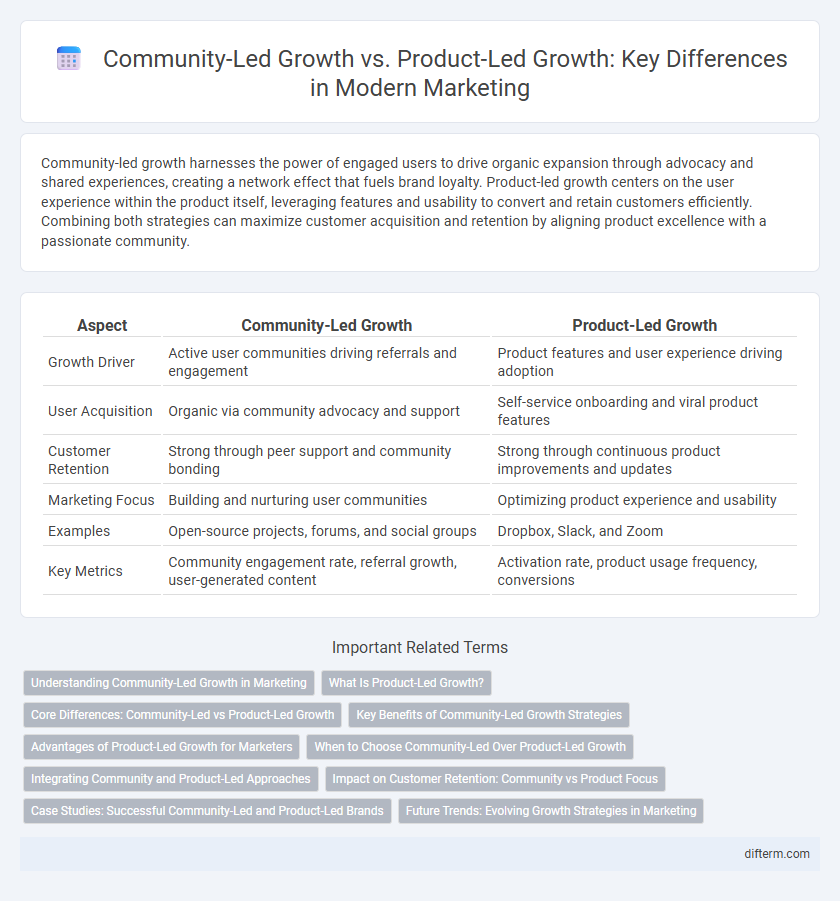Community-led growth harnesses the power of engaged users to drive organic expansion through advocacy and shared experiences, creating a network effect that fuels brand loyalty. Product-led growth centers on the user experience within the product itself, leveraging features and usability to convert and retain customers efficiently. Combining both strategies can maximize customer acquisition and retention by aligning product excellence with a passionate community.
Table of Comparison
| Aspect | Community-Led Growth | Product-Led Growth |
|---|---|---|
| Growth Driver | Active user communities driving referrals and engagement | Product features and user experience driving adoption |
| User Acquisition | Organic via community advocacy and support | Self-service onboarding and viral product features |
| Customer Retention | Strong through peer support and community bonding | Strong through continuous product improvements and updates |
| Marketing Focus | Building and nurturing user communities | Optimizing product experience and usability |
| Examples | Open-source projects, forums, and social groups | Dropbox, Slack, and Zoom |
| Key Metrics | Community engagement rate, referral growth, user-generated content | Activation rate, product usage frequency, conversions |
Understanding Community-Led Growth in Marketing
Community-led growth in marketing leverages active user communities to drive brand engagement, product adoption, and organic expansion by fostering shared experiences and peer-to-peer interactions. This approach relies on authentic community contributions, user-generated content, and collective problem-solving to enhance customer loyalty and advocacy. Marketers prioritize building and nurturing these communities to create sustainable growth through trust and social proof rather than solely focusing on product features or direct sales tactics.
What Is Product-Led Growth?
Product-Led Growth (PLG) is a business strategy where the product itself drives user acquisition, expansion, and retention by delivering exceptional user experience and value. Key metrics in PLG include user activation rates, product engagement, and viral coefficient, emphasizing self-service and seamless onboarding. Companies like Slack and Dropbox exemplify PLG by leveraging intuitive features that encourage organic adoption without heavy reliance on traditional sales teams.
Core Differences: Community-Led vs Product-Led Growth
Community-led growth centers on building and nurturing user communities to drive organic engagement, trust, and brand advocacy, leveraging social interactions as a growth engine. Product-led growth emphasizes seamless user experience and product value as the primary drivers for acquisition, retention, and expansion, relying on features, onboarding, and in-app triggers. The core difference lies in community-led growth prioritizing human connection and interaction, while product-led growth focuses on self-service product adoption and usage metrics.
Key Benefits of Community-Led Growth Strategies
Community-led growth strategies foster deep customer engagement by leveraging active user communities to drive product adoption and advocacy, resulting in higher retention rates and organic referrals. These strategies enhance brand loyalty through authentic peer-to-peer interactions, creating a sustainable growth loop fueled by shared experiences and collective problem-solving. By prioritizing community involvement, businesses can reduce acquisition costs while accelerating feedback cycles, enabling continuous product improvement aligned with user needs.
Advantages of Product-Led Growth for Marketers
Product-led growth empowers marketers to leverage the product itself as the primary driver of customer acquisition, reducing reliance on traditional advertising channels and lowering customer acquisition costs. It enables real-time data collection on user behavior, allowing for targeted marketing strategies and personalized customer experiences that enhance engagement and retention. This approach fosters organic growth through user satisfaction and product virality, resulting in scalable and sustainable business expansion.
When to Choose Community-Led Over Product-Led Growth
Community-led growth is ideal when customer engagement, loyalty, and advocacy are crucial for scaling, especially in markets where trust and peer recommendations strongly influence purchasing decisions. It thrives with products requiring education, feedback loops, and deeper user involvement, such as complex SaaS platforms or niche B2B services. Product-led growth suits scenarios where frictionless user experience and rapid product adoption drive expansion, but community-led strategies outperform when building long-term value through network effects and organic user-driven content.
Integrating Community and Product-Led Approaches
Integrating community-led growth with product-led growth creates a synergistic approach where user feedback from active communities directly informs product development, enhancing user experience and retention. This combined strategy leverages authentic community advocacy to drive organic growth while using data-driven product enhancements to attract and convert prospects. Brands that align community insights with product features effectively boost engagement, reduce churn, and accelerate scalable growth in competitive markets.
Impact on Customer Retention: Community vs Product Focus
Community-led growth significantly enhances customer retention by fostering strong, interactive networks where users share experiences and provide peer support, creating a sense of belonging and loyalty. Product-led growth relies on the intrinsic value and usability of the product itself to retain customers, often resulting in higher initial adoption but less emotional engagement over time. Brands leveraging community-led strategies typically achieve sustained retention rates through continual user interaction and advocacy, outperforming purely product-focused approaches in long-term customer loyalty.
Case Studies: Successful Community-Led and Product-Led Brands
Case studies reveal that community-led growth brands like Lego and Glossier achieve higher customer loyalty through active user engagement and advocacy, fostering authentic connections that drive organic expansion. Product-led growth companies such as Slack and Dropbox prioritize seamless user experience and rapid onboarding to accelerate adoption and retention rates, showcasing scalable, data-driven growth. These examples illustrate how integrating community engagement or product excellence can strategically fuel sustainable market dominance.
Future Trends: Evolving Growth Strategies in Marketing
Community-led growth leverages the power of user engagement and network effects to create authentic brand advocates, driving organic expansion and sustained loyalty. Product-led growth emphasizes seamless user experience and product innovation, converting users through value-first product interactions without heavy reliance on traditional sales channels. Future marketing strategies increasingly blend both approaches, utilizing AI-driven analytics to optimize community engagement and personalize product experiences for scalable, data-driven growth.
Community-led growth vs product-led growth Infographic

 difterm.com
difterm.com